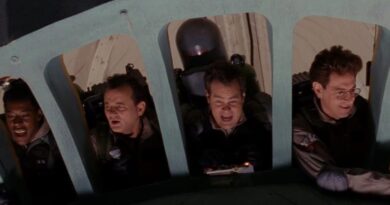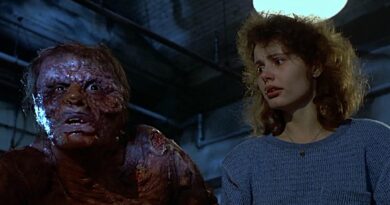Labyrinth (1986)
In 1982, Jim Henson made The Dark Crystal, a film brought to life with puppetry and yet was distant from the fun, lighthearted innocence of his previous Muppet films and TV shows. Now he has made Labyrinth, and while it once again relies on puppets that look and sound nothing like their Muppet cousins, it relies a lot on very Muppet-like moments of levity, from slapstick physicality to witty bits of dialogue, the latter undoubtedly because of a screenplay by Monty Python alum Terry Jones. This is in stark contrast to The Dark Crystal, which was criticized in some circles for being too dark and mature for younger audiences. There’s absolutely nothing wrong with family-friendly jokes, although I do believe, generally speaking, that children can tolerate dark stories better than many adults give them credit for.
I enjoyed The Dark Crystal, although I was also somewhat disappointed by its lack of originality, the story relying on just about every hero’s-journey cliché there is. What I now know is that, though unoriginal, its story was nevertheless solid. The same cannot be said of Labyrinth. Narratively speaking, it isn’t as sure of itself. The premise is shaky. The characters aren’t as well developed. Though its intention to be a coming-of-age fable is obvious, it sometimes loses sight of what it sets out to accomplish. This is partly because of David Bowie. As the main villain, the charismatic ruler of a fairy-tale kingdom surrounded by an expansive and daunting labyrinth, he’s an engaging presence; as the composer and performer of the film’s songs, he makes questionable choices, for at no point do his melodies or lyrics seem to propel the plot. Nothing about the film necessitated it be a musical in the first place.
In spite of everything I’ve just said, I am recommending the film for its visual appeal and repeated displays of creativity. Among its accomplishments are: A shaft of gnarled human hands, which join together to form faces that can actually talk; a physical reconstruction of M.C. Escher’s Relativity lithograph; immense double doors that each contain half of a hulking, axe-wielding robotic guard; and a fantasy sequence in which an ornate, vaguely Venetian masquerade is held within the confines of a floating crystal ball. Credit also to the puppeteers and technicians for making the creatures seem lifelike, and to conceptual designer Brian Froud for his unique vision of goblins, gnomes, and beasts, a vision he also applied to The Dark Crystal.
The plot involves a teenage girl named Sarah (Jennifer Connelly) trying to solve the title labyrinth in an effort to save her infant brother Toby, having selfishly wished Bowie’s character, the Goblin King Jareth, to take him away. The labyrinth is a Wonderland-esque topsy-turvy world of glitter-encrusted stone walls, forests, bogs, landfills, and miniature cities. Sarah comes into contact with an assortment of side characters, some friendly, some malicious, some just plain odd. These would include: A crabby, wizened dwarf named Hoggle (performed by Shari Weiser, voiced by Brian Henson); a simple-minded gentle giant named Ludo (performed by Rob Mills, voiced by Ron Mueck), who has the ability to vocally summon rocks and boulders; and a terrier-like guard named Sir Didymus (performed by Dave Goelz, voiced by David Shaughnessy), chivalrous and noble to a pointless yet amusing extreme.
Although it’s clearly established that Jareth takes Toby at Sarah’s request, his reasons for wanting to claim Toby as his own and trying to stall and deceive Sarah at every turn is left somewhat obscure. Confusing matters further, it seems Jareth is falling in love with Sarah – or, at the very least, is attracted to the idea of Sarah regarding him as cunning, intimidating, and all-powerful. Does he want a lover or a devotee? Why would he want either if his intention is to keep her away from Toby and turn him into a goblin minion? Why would Jareth consider that an accomplishment? Even within the heightened world of a fairy tale, motivations have to be understandable and grounded in logic.
Much has been made of the fact that Labyrinth was executive produced by George Lucas. To an extent, you can understand why; like Lucas with a certain 1977 movie that became a cultural phenomenon, Jim Henson wanted to tell a simple story in the language of a populist film genre, fantasy in this case. I’m sure it helped that Henson’s studio was responsible for the creation of the Yoda character from the last two Star Wars movies. However, as one of the people responsible for getting Labyrinth funded, I can’t help but wonder why Lucas wasn’t more aware of or more willing to speak out against the film’s obvious shortcomings throughout production. As much as I want you to see this movie, be aware that it succeeds more visually than narratively.




